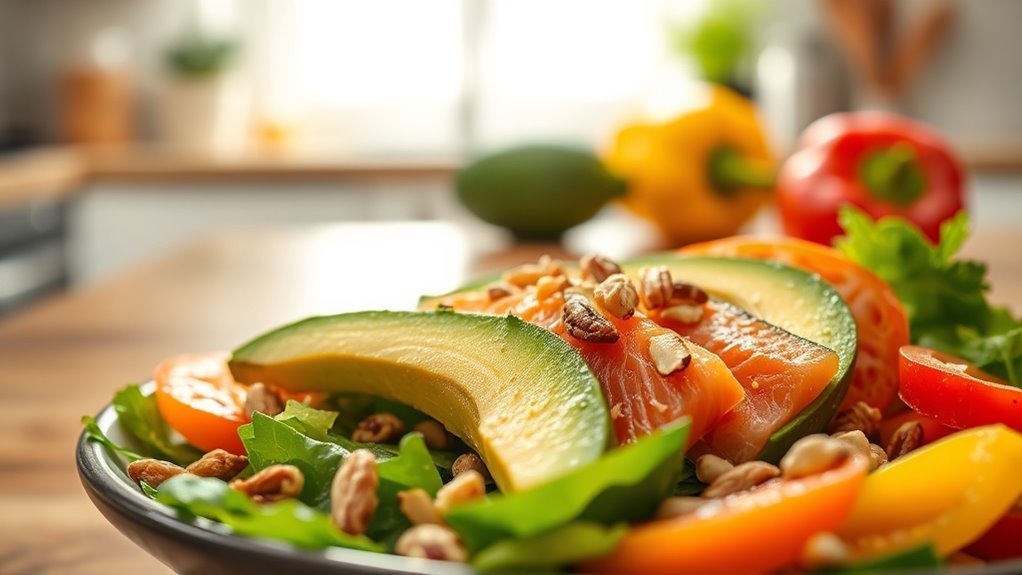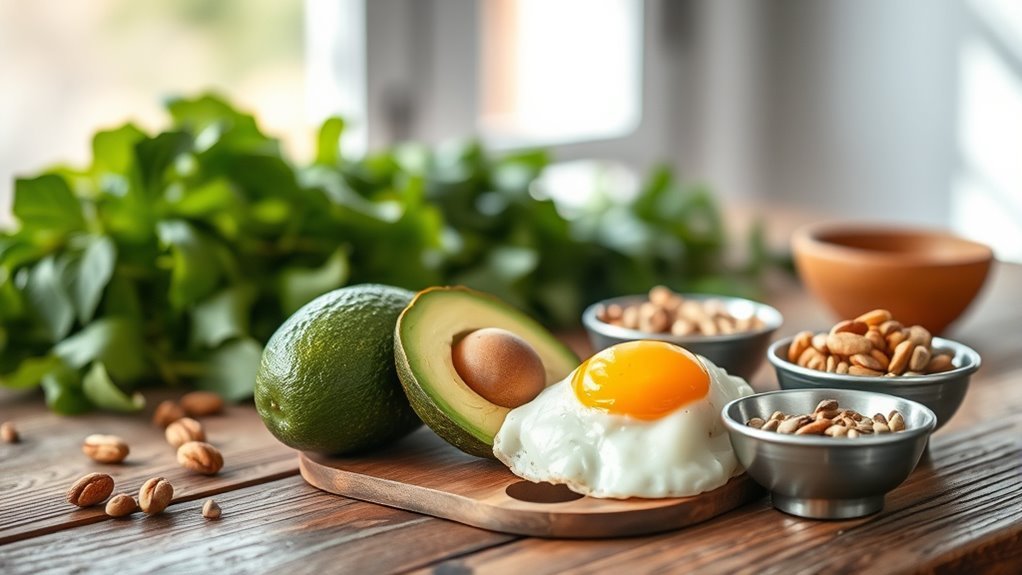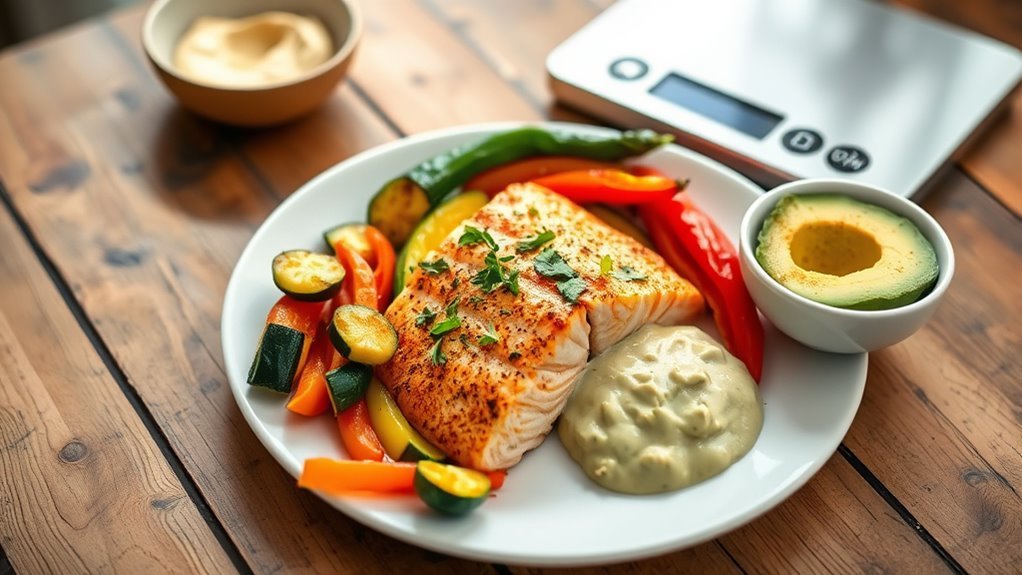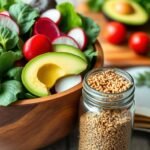In a keto diet, you generally want to limit your carb intake to around 20 to 50 grams per day. This helps your body enter ketosis, where it’s burning fat for fuel instead of glucose. Individual factors, like your activity level and metabolism, can influence how many carbs you can consume. It’s also important to understand the difference between net carbs and total carbs for better management. If you’re curious about more tips for staying on track, keep exploring.
Understanding Ketosis and Carbohydrate Intake

When you begin a keto diet, understanding ketosis and how carbohydrate intake affects it is essential. The ketosis process occurs when your body shifts from burning glucose to fat for fuel, primarily due to reduced carb intake. By limiting carbohydrates, you alter your carb metabolism, prompting your liver to produce ketones. These ketones serve as an alternative energy source, which can lead to increased fat burning and weight loss. However, exceeding your carb limits can disrupt this metabolic state, preventing you from achieving the benefits of ketosis. Balancing your carb consumption is key to maintaining this beneficial metabolic state. By grasping these concepts, you empower yourself to navigate your keto journey with confidence and freedom.
Recommended Daily Carb Limits for Keto

Typically, a ketogenic diet limits carbohydrate intake to about 20 to 50 grams per day, depending on individual factors like activity level and metabolic health. To effectively manage your carb limits during keto meal planning, consider these key points:
- Track Your Intake: Using apps or food diaries helps you stay within your carb limits.
- Prioritize Quality: Focus on low-carb vegetables and healthy fats to nourish your body.
- Explore Carb Cycling: This strategy allows you some flexibility by alternating low-carb days with higher-carb days, enhancing your metabolic flexibility.
Finding the right balance can empower you to enjoy your meals and maintain your lifestyle while still reaching your health goals. Embrace the freedom of choice in your keto journey!
Factors Influencing Carb Requirements

Individual carbohydrate requirements on a keto diet can vary widely based on several factors. Your individual metabolism plays a significant role in determining how many carbs you can handle while staying in ketosis. Dietary preferences and activity level also affect your carb needs; for example, more active individuals may require slightly higher carb intake. Health conditions, age factors, and genetic predisposition can further shape your unique requirements. Additionally, meal timing and carb timing can influence how your body processes carbohydrates. Prioritizing food quality is essential, as whole foods can provide better nutrients and support overall health. Ultimately, your lifestyle choices will guide your carb intake, allowing you to tailor your keto experience to fit your personal goals and well-being.
The Importance of Net Carbs vs. Total Carbs
When following a keto diet, understanding the difference between net carbs and total carbs is essential. Net carbs are calculated by subtracting fiber and certain sugar alcohols from total carbohydrates, which can greatly affect your daily carb intake. By focusing on net carbs, you can better manage your diet while still enjoying a variety of foods.
Defining Net Carbs
Understanding the concept of net carbs is essential for anyone following a keto diet, as it directly impacts your ability to maintain ketosis. The net carb definition focuses on the carbs your body actually processes, excluding fiber and certain sugar alcohols that don’t spike your blood sugar. This helps you enjoy more food freedom while staying within your carb limits.
When calculating net carbs, consider:
- Total Carbs: The overall carbohydrate count in your food.
- Fiber: Subtract fiber since it’s not digested.
- Sugar Alcohols: Depending on the type, some can be partially subtracted.
Calculating Total Carbs
Calculating total carbs is essential for anyone on a keto diet, as it sets the foundation for determining your net carb intake. Understanding the difference between total and net carbs empowers you to make informed food choices. Use reliable carb measurement techniques, like food labels and tracking apps, to accurately assess your intake. Remember, daily carb variations can greatly impact your ketosis, so stay vigilant. While some foods may be lower in total carbs, they might also contain fibers and sugar alcohols that affect your net carb count. By focusing on total carbs, you can better navigate your diet, ensuring you maintain the freedom to enjoy a variety of foods while sticking to your keto goals.
Tracking Your Carb Intake Effectively
How can you guarantee you’re effectively tracking your carb intake on a keto diet? By using reliable methods, you’ll maintain your freedom while staying on track. Here are three effective methods for carb tracking:
- Food Diary: Keep a daily log of everything you eat, making it easier to spot patterns and adjust as needed.
- Apps: Utilize digital tools like MyFitnessPal or Cronometer to automate tracking and provide instant feedback.
- Label Reading: Get in the habit of checking food labels for net carbs, helping you make informed choices.
Common Keto-Friendly Foods and Their Carb Counts
When following a keto diet, knowing the carb counts of common foods is essential. You’ll want to focus on low-carb vegetables, select protein sources, and satisfying keto snacks that keep your carb intake in check. Let’s explore these categories to help you make informed choices.
Low-Carb Vegetables Overview
While many people associate vegetables with high carbohydrate content, there are plenty of low-carb options that fit perfectly into a keto diet. Incorporating these veggies into your meals can offer significant vegetable benefits, such as essential nutrients and fiber without the excess carbs. Here are three keto-friendly choices to examine:
- Spinach – Packed with vitamins and just 1g of net carbs per cup, it’s great for salads or smoothies.
- Broccoli – A cruciferous vegetable with about 4g of net carbs per cup, it’s versatile and filling.
- Zucchini – With only 2g of net carbs per cup, it’s perfect for zoodles or as a side dish.
These leafy greens and cruciferous vegetables can help keep your carb content low while maximizing nutrition.
Protein Sources Carb Count
In addition to incorporating low-carb vegetables, understanding protein sources and their carb counts is essential for anyone following a keto diet. You’ll want to choose wisely among lean meats, dairy products, and seafood options. Here’s a quick reference table to help you:
| Protein Source | Carb Count (per 100g) | Notes |
|---|---|---|
| Chicken Breast | 0 | Lean meat |
| Greek Yogurt | 4 | Dairy product |
| Tofu | 1.9 | Plant protein |
| Salmon | 0 | Great seafood option |
Egg benefits are undeniable, and nut varieties can be enjoyed in moderation. Consider protein powders or legumes alternatives for your protein timing to stay within carb limits while enjoying your meals!
Keto Snacks Analysis
Snacking on a keto diet can be both satisfying and compliant with your carb limits, provided you choose the right options. Here are three great keto snack options to evaluate:
- Cheese Crisps: A crunchy, savory snack idea, these are low in carbs and high in healthy fats.
- Nut Butter Packs: Portable keto snacks that offer a creamy texture and satisfying taste, perfect for on-the-go low carb treats.
- Dark Chocolate: Look for a variety with at least 70% cocoa for a sweet keto alternative that’s still low in carbs.
These healthy fat snacks not only keep you within your carb limits but also provide energy and satisfaction while enjoying the freedom of your keto lifestyle.
Adjusting Carb Intake for Weight Loss or Maintenance
Adjusting your carb intake is essential for effectively managing weight, whether you’re aiming for loss or maintenance on a keto diet. To achieve your goals, you’ll want to focus on adjusting macros based on your individual needs. Personalized plans can make a significant difference, as everyone’s metabolism and lifestyle vary.
Generally, keeping your daily carb intake between 20 to 50 grams can help you stay in ketosis. However, if you’re looking to maintain weight, you might find that slightly increasing your carbs can still fit within your keto framework. Tracking your progress and being flexible with your carb intake allows for a more sustainable approach. Remember, it’s about finding the right balance that works for you, giving you the freedom to enjoy your food.
Potential Challenges and Solutions for Staying Within Carb Limits
While you may find the keto diet effective for weight loss, staying within carb limits can present some challenges that require attention. Here are a few common issues and their solutions:
The keto diet can be effective for weight loss, but managing carb limits may pose challenges.
- Carb Cravings: These can be intense, especially during the initial phase. Combat them by increasing healthy fats in your meals to feel more satisfied.
- Meal Planning: Without proper planning, you might inadvertently consume hidden carbs. Create a weekly meal plan focusing on low-carb recipes and prep snacks in advance.
- Social Situations: Dining out can be tricky. Look up menus beforehand and consider bringing your own low-carb options to gatherings.


